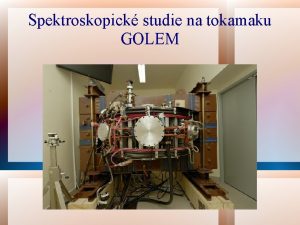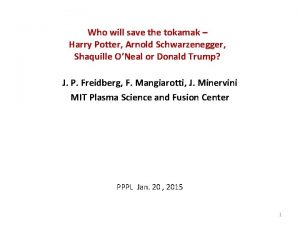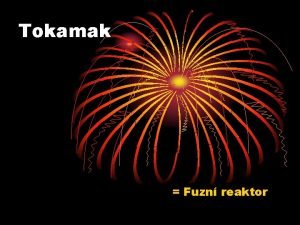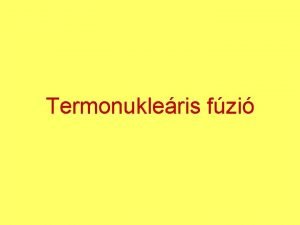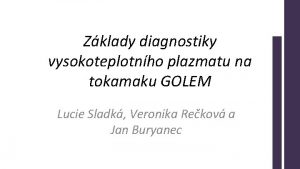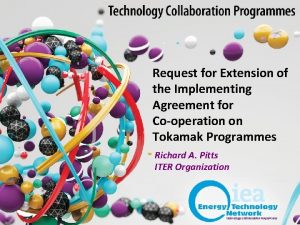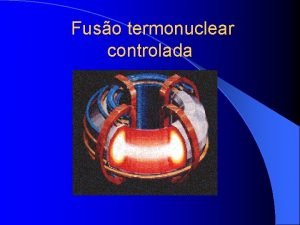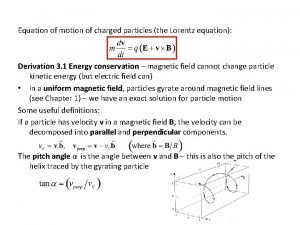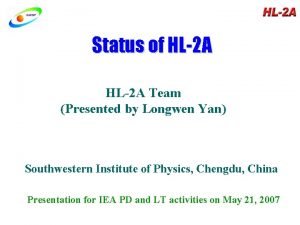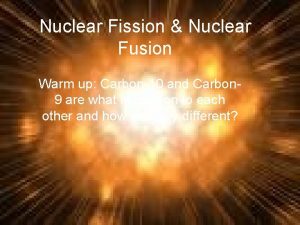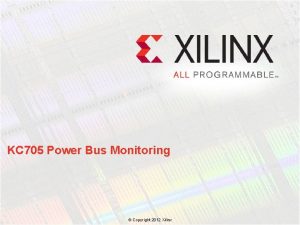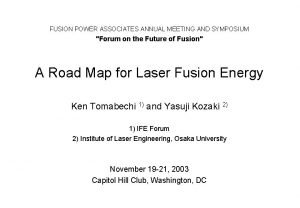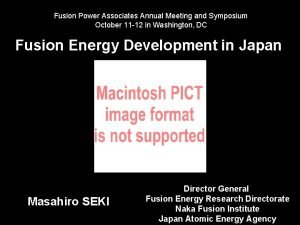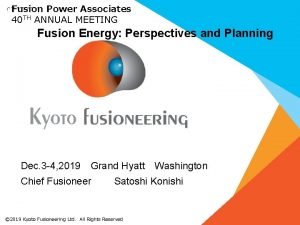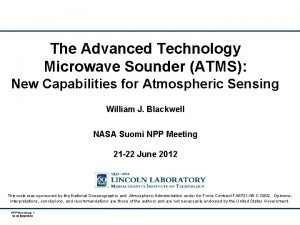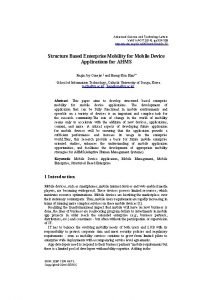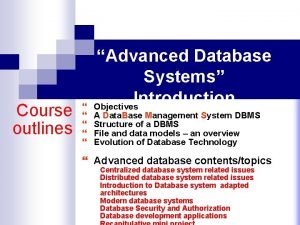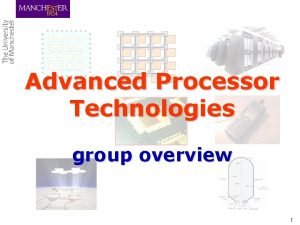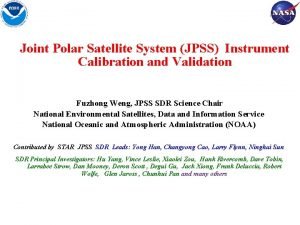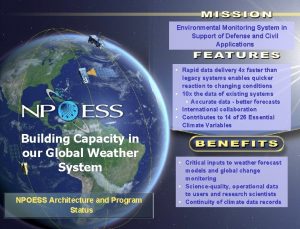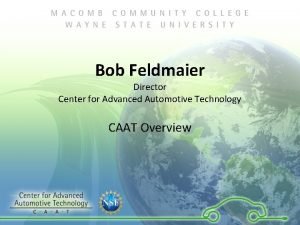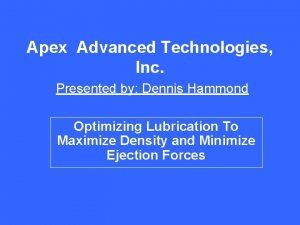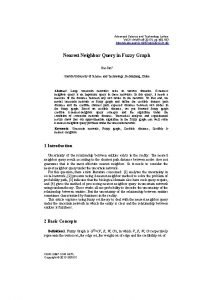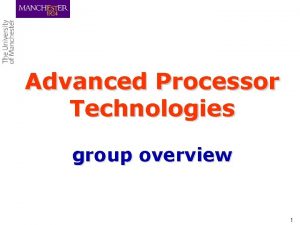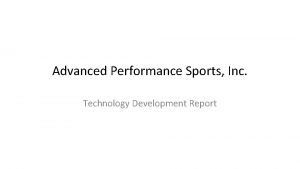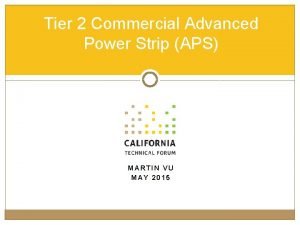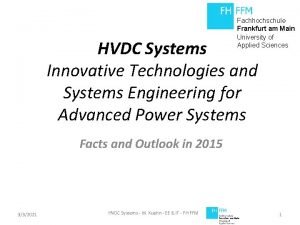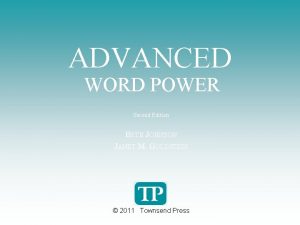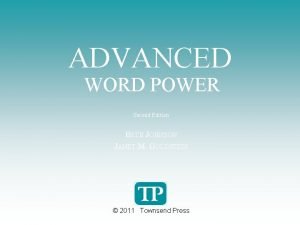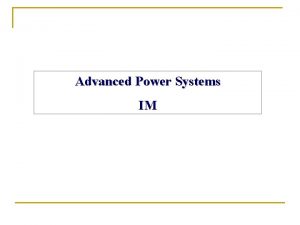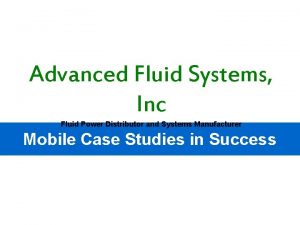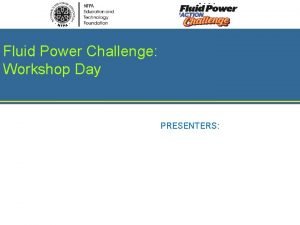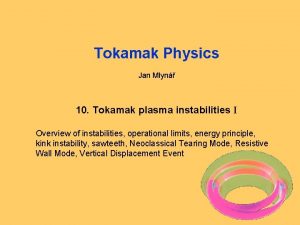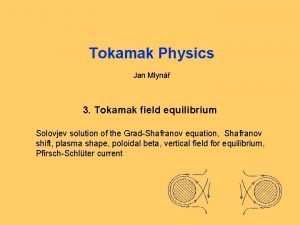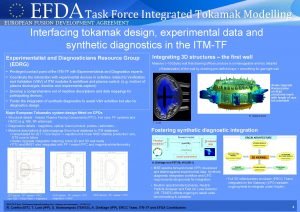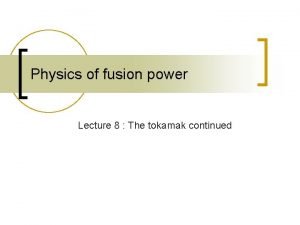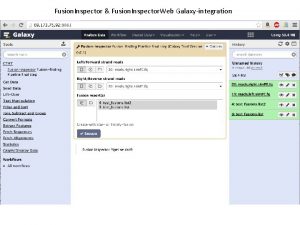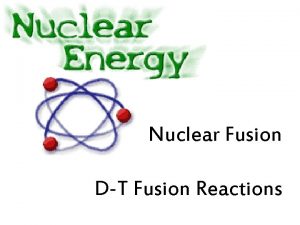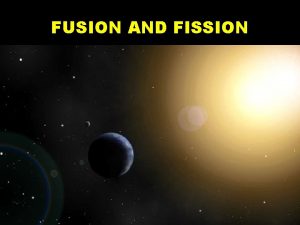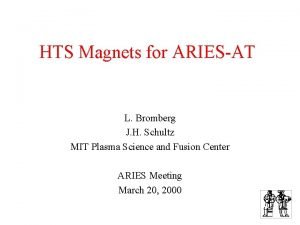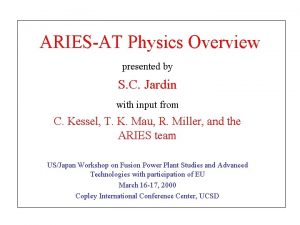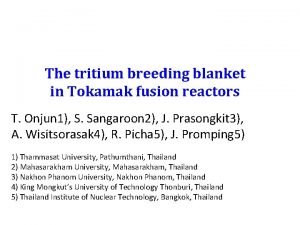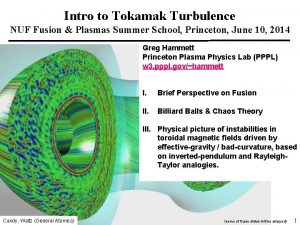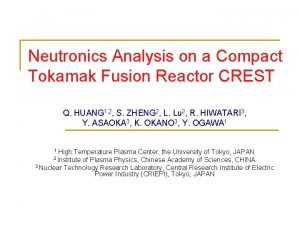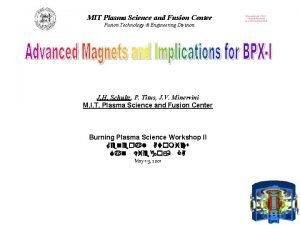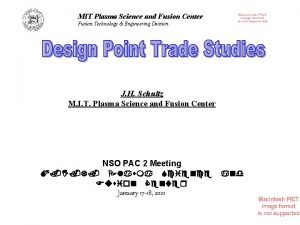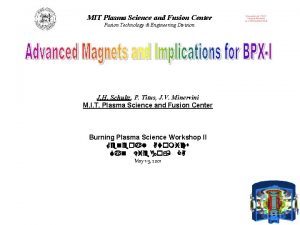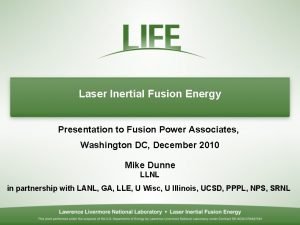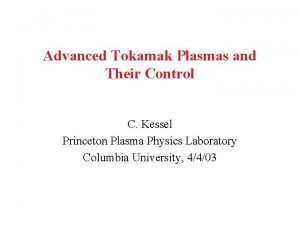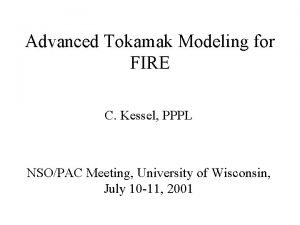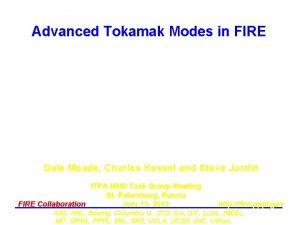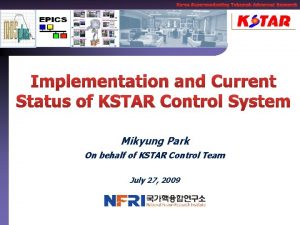ARIESAT An Advanced Tokamak Advanced Technology Fusion Power






































- Slides: 38

ARIES-AT: An Advanced Tokamak, Advanced Technology Fusion Power Plant Farrokh Najmabadi University of California, San Diego, La Jolla, CA, United States of America 9 th Course on Technology of Fusion Reactors 26 July – 1 August 2004 Erice Italy Electronic Copy: ARIES Web Site: http: //aries. ucsd. edu/PUBLIC

ARIES Research Framework: Identify Key R&D Issues and Provide a Vision for Fusion Research Periodic Input from Energy Industry Goals and Requirements Scientific & Technical Achievements Projections and Design Options Evaluation Based on Customer Attributes Attractiveness No: Redesign Characterization of Critical Issues Feasibility Balanced Assessment of Attractiveness & Feasibility Yes R&D Needs and Development Plan

ARIES Designs Are Developed Based on a Reasonable Extrapolation of Physics & Technology ARIES Rules Ø Plasma regimes of operation are optimized based on latest experimental achievements and/or “well-founded” theoretical predictions. Ø Engineering system is based on “evolution” of present-day technologies, i. e. , they should be available at least in small samples now. Only learning-curve cost credits are assumed in costing the system components. Optimization involves trade-off among Physics and Engineering constraints and parameters Ø Trade-off between vertical stability and plasma shape (and b) and fusion core configuration and blanket thickness. Ø Trade-off between plasma edge condition and plasma facing components capabilities Ø. . .

Customer Requirements

Top-Level Requirements for Fusion Power Plants Was Developed in Consultation with US Industry Public Acceptance: Ø No public evacuation plan is required: total dose < 1 rem at site boundary; Ø Generated waste can be returned to environment or recycled in less than a few hundred years (not geological time-scale); Ø No disturbance of public’s day-to-day activities; Ø No exposure of workers to a higher risk than other power plants; Reliable Power Source: Ø Closed tritium fuel cycle on site; Ø Ability to operate at partial load conditions (50% of full power); Ø Ability to maintain power core (availability > 80%); Ø Ability to operate reliably with < 0. 1 major unscheduled shut-down per year. Ø Economic Competitiveness: Above requirements must be achieved simultaneously and consistent with a competitive life-cycle cost of electricity.

Directions for Optimization

Translation of Requirements to GOALS for Fusion Power Plants Ø Have an economically competitive life-cycle cost of electricity: COE has a “hyperbolic” • Low recirculating power (Increase plasma Q, …); dependence ( 1/x) and • High power density (Increase Pf ~ b 2 BT 4 , …) improvements “saturate” • High thermal conversion efficiency; after certain limit • Less-expensive systems. Ø Gain Public acceptance by having excellent safety and environmental characteristics: • Use low-activation and low toxicity materials and care in design. Ø Have operational reliability and high availability: • Ease of maintenance • Design margins, and extensive R&D. Ø Acceptable cost of development. Stay close to present-day Larger extrapolation from present Requirements:

There Is Little Economic Benefit for Operating Beyond ~ 5 MW/m 2 of Wall Load (for 1000 MWe) Ø Simple analysis for a cylindrical plasma with length L: Systems code What we pay for, VFPC r ARIES-RS D Hyperbolic dependence Wall loading Iw 1/r D is set by neutron mfp VFPC = p L ( 2 r. D + D 2) For r >> D , VFPC 2 p Lr. D 1 / Iw For r << D , VFPC 2 p L D 2 const. Ø “Knee of the curve” is at r D Ø Physics & Engineering constraints cause departure from geometrical dependence e. g. , high field needed for high load increases TF cost. Ø ARIES-AT optimizes at lower wall loading because of high efficiency.

Continuity of ARIES research has led to the progressive refinement of research Improved Physics ARIES-I (1990): • Trade-off of b with bootstrap • High-field magnets to compensate for low b ARIES-II/IV, 2 nd Stability (1992): • High b only with too much bootstrap • Marginal reduction in current-drive power ARIES-RS, reverse shear (1996): • Improvement in b and current-drive power • Approaching COE insensitive of power density ARIES-AT, reverse shear (2000): • Approaching COE insensitive of current-drive • High b is used to reduce toroidal field Need high b equilibria with high bootstrap Need high b equilibria with aligned bootstrap Better bootstrap alignment More detailed physics

Evolution of ARIES Designs 1 st Stability, High-Field Nb 3 Sn Tech. Option Reverse Shear Option ARIES-I’ ARIES-I 8. 0 6. 75 5. 2 2% (2. 9) 2% (3. 0) 5% (4. 8) 9. 2% (5. 4) Peak field (T) 16 19 16 11. 5 Avg. Wall Load (MW/m 2) 1. 5 2. 5 4 3. 3 Current-driver power (MW) 237 202 81 36 Recirculating Power Fraction 0. 29 0. 28 0. 17 0. 14 Thermal efficiency 0. 46 0. 49 0. 46 0. 59 10 8. 2 7. 5 5 Major radius (m) b (b. N) Cost of Electricity (c/k. Wh) ARIES-RS ARIES-AT Approaching COE insensitive of power density Approaching COE insensitive of current drive

ARIES-AT Physics Analysis

ARIES-AT: Physics Highlights Ø We used the lessons learned in ARIES-ST optimization to reach a higher performance plasma; * Using > 99% flux surface from free-boundary plasma equilibria rather than 95% flux surface used in ARIES-RS leads to larger elongation and triangularity and higher stable b. Ø ARIES-AT blanket allows vertical stabilizing shell closer to the plasma, leading to higher elongation and higher b. Ø Detailed stability analysis indicated that H-mode pressure & current profiles and X-point improves ballooning stability. Ø A kink stability shell (t = 10 ms), 1 cm of tungsten behind the blanket, is utilized to keep the power requirements for n = 1 resistive wall mode feedback coil at a modest level.

ARIES-AT: Physics Highlights Ø We eliminated HHFW current drive and used only lower hybrid for off-axis current drive. Ø Self-consistent physics-based transport simulations indicated the optimized pressure and current profiles can be sustained with a peaked density profile. Ø A radiative divertor is utilized to keep the peak heat flux at the divertor at ~ 5 MW/m 2. Ø Accessible fueling; No ripple losses; 0 -D consistent startup; etc. Ø As a whole, we performed detailed, self-consistent analysis of plasma MHD, current drive, transport, and divertor (using finite edge density, finite p , impurity radiation, etc. )

The ARIES-AT Equilibrium is the Results of Extensive ideal MHD Stability Analysis Ø Pressure profiles scans show the interplay between plasma b and bootstrap alignment – optimum profiles are NOT at the highest b. Ø Intermediate n kink sets the wall location Ø ARIES-AT plasma operates at 90% of theoretical b limit.

Vertical Stability and Control is a Critical Physics/Engineering Interface Ø TSC nonlinear dynamic simulations of vertical stability and feedback control show the tradeoff of power and accessible plasmas Ø ARIES-AT elongation of k = 2. 2 is consistent with allowed stabilizer location

Major Plasma Parameters of ARIES-AT Aspect ratio Major toroidal radius (m) Plasma minor radius (m) Plasma elongation (kx) Plasma triangularity (dx) Toroidal b ‡ Normalize b. N ‡ Electron density (1020 m-3) ITER-89 P scaling multiplier Plasma current On-axis toroidal field (T) Current-drive power to plasma (MW) ‡ 4. 0 5. 2 1. 3 2. 2 0. 84 9. 2% 5. 4 2. 3 2. 6 13 6 36 ARIES-AT plasma operates at 90% of maximum theoretical limit

ARIES-AT Engineering Analysis

ARIES-AT Fusion Core

Fusion Core Is Segmented to Minimize the Rad-Waste Blanket 1 (replaceable) Blanket 2 (lifetime) Shield (lifetime) Ø Only “blanket-1” and divertors are replaced every 5 years

ARIES-I Introduced Si. C Composites as A High. Performance Structural Material for Fusion Ø Excellent safety & environmental characteristics (very low activation and very low afterheat). Ø High performance due to high strength at o high temperatures (>1000 C). Ø Large world-wide program in Si. C: * New Si. C composite fibers with proper stoichiometry and small O content. * New manufacturing techniques based on polymer infiltration results in much improved performance and cheaper components. * Recent results show composite thermal conductivity (under irradiation) close to 15 W/m. K which was used for ARIES-I.

Improved Blanket Technology Continuity of ARIES research has led to the progressive refinement of research ARIES-I: • Si. C composite with solid breeders • Advanced Rankine cycle Starlite & ARIES-RS: • Li-cooled vanadium • Insulating coating ARIES-ST: • Dual-cooled ferritic steel with Si. C inserts • Advanced Brayton Cycle at 650 o. C ARIES-AT: • Li. Pb-cooled Si. C composite • Advanced Brayton cycle with h = 59% Many issues with solid breeders; Rankine cycle efficiency saturate at high temperature Max. coolant temperature limited by maximum structure temperature High efficiency with Brayton cycle at high temperature

Advanced Brayton Cycle Parameters Based on Present or Near Term Technology Evolved with Expert Input from General Atomics* • Min. He Temp. in cycle (heat sink) = 35°C • 3 -stage compression with 2 intercoolers • Turbine efficiency = 0. 93 • Compressor efficiency = 0. 88 • Recuperator effectiveness (advanced design) = 0. 96 • Cycle He fractional DP = 0. 03 • Intermediate Heat Exchanger Effectiveness = 0. 9 (m. Cp)He/(m. Cp)Pb-17 Li = 1 Ø Key improvement is the development of cheap, high-efficiency recuperators. *R. Schleicher, A. R. Raffray, C. P. Wong, "An Assessment of the Brayton Cycle for High Performance Power Plant, " 14 th ANS Topical Meeting on Technology of Fusion Energy, October 15 -19, 2000, Park City Utah

Recent Advances in Brayton Cycle Leads to Power Cycles With High Efficiency T 1 11 9 8 He Divertor Coolant 2' 10 2 9' 5' 7' 6 Divertor 3 4 S 11 9 Intercooler 1 Intercooler 2 Blanket Li. Pb Blanket Coolant 10 Recuperator Intermediate HX 3 Compressor 1 5 6 7 Compressor 2 1 8 W net Compressor 3 Turbine 2 4 Heat Rejection HX

ARIES-AT: Si. C Composite Blankets Ø Simple, low pressure design with Si. C structure and Li. Pb coolant and breeder. Ø Innovative design leads to high Li. Pb outlet temperature (~1, 100 o. C) while keeping Si. C structure temperature below 1, 000 o. C leading to a high thermal efficiency of ~ 60%. Ø Simple manufacturing technique. Ø Very low afterheat. Ø Class C waste by a wide margin. Ø Li. Pb-cooled Si. C composite divertor is capable of 5 MW/m 2 of heat load. Outboard blanket & first wall

Develop Plausible Fabrication Procedure and Minimize Joints in High Irradiation Region 1. Manufacture separate halves of the Si. Cf/Si. C poloidal module by Si. Cf weaving and Si. C Chemical Vapor Infiltration (CVI) or polymer process; 2. Manufacture curved section of inner shell in one piece by Si. Cf weaving and Si. C Chemical Vapor Infiltration (CVI) or polymer process; 3. Slide each outer shell half over the freefloating inner shell; 1 2 4. Braze the two half outer shells together at the midplane; 5. Insert short straight sections of inner shell at each end; Brazing procedure selected for reliable joint contact area 3 4 5

Multi-Dimensional Neutronics Analysis to Calculate Tritium Breeding Ratio and Heat Generation Profiles • Latest data and code • 3 -D tritium breeding > 1. 1 to account for uncertainties • Blanket configuration and zone thicknesses adjusted accordingly • Blanket volumetric heat generation profiles used for thermal-hydraulic analyses

Innovative Design Results in a Li. Pb Outlet Temperature of 1, 100 o. C While Keeping Si. C Temperature Below 1, 000 o. C • Pb. Li Inlet Temp. = 764 °C Max. Si. C/Si. C Temp. = 996°C° Max. Si. C/Pb. Li Interf. Temp. = 994 °C Bottom Top Pb. Li outlet temp = 1100 °C Two-pass Pb. Li flow, first pass to cool Si. Cf/Si. C box second pass to superheat Pb. Li

Details of Thermal Analysis of ARIES-AT First Wall Channel and Inner Channel Model Description: Ø Assume MHD-flowlaminarization effect Ø Use plasma heat flux poloidal profile Ø Use volumetric heat generation poloidal and radial profiles Ø Iterate for consistent boundary conditions for heat flux between Pb-17 Li inner channel zone and first wall zone Ø Calibration with ANSYS 2 -D results Parameters Ø Pb. Li Inlet Temperature = 764 °C Ø Pb. Li Outlet Temperature = 1, 100 °C Radial build (from plasma side: ) Ø CVD Si. C Thickness = 1 mm Ø Si. Cf/Si. C Thickness = 4 mm (Si. Cf/Si. C k = 20 W/m-K) Ø Pb. Li Channel Thick. = 4 mm Ø Si. C/Si. C Separator Thickness = 5 mm (Si. Cf/Si. C k = 6 W/m-K) Ø Pb. Li velocity in FW Channel= 4. 2 m/s Ø Pb. Li velocity in inner Channel = 0. 1 m/s

ARIES-AT Outboard Blanket Parameters Number of Segments Number of Modules per Segment Module Poloidal Dimension Average Module Toroidal Dimension First Wall Si. Cf/Si. C Thickness First Wall CVD Si. C Thickness First Wall Annular Channel Thickness Average Pb-17 Li Velocity in First Wall Channel Re First Wall Channel Transverse Ha MHD Turbulent Transition Re First Wall MHD Pressure Drop Maximum Si. Cf/Si. C Temperature Maximum CVD Si. C Temperature Maximum Pb-17 Li/Si. C Interface Temperature Average Pb-17 Li Velocity in Inner Channel 32 6 6. 8 m 0. 19 m 4 mm 1 mm 4. 2 m/s 3. 9 x 105 4340 2. 2 x 106 0. 19 MPa 996°C 1, 009 °C 994°C 0. 11 m/s

Multi-Dimensional Neutronics Analysis was Performed to Calculate TBR, activities, & Heat Generation Profiles Ø Very low activation and afterheat Lead to excellent safety and environmental characteristics. Ø All components qualify for Class-C disposal under NRC and Fetter Limits. 90% of components qualify for Class-A waste. Ø On-line removal of Po and Hg from Li. Pb coolant greatly improves the safety aspect of the system and is relatively straight forward.

Major Engineering Parameters of ARIES-AT Fusion power (MW) Energy Multiplication, M Thermal Power (MW) Peak/Avg. first wall heat flux (MW/m 2) Peak/Avg. neutron wall load (MW/m 2) Li. Pb coolant outlet temperature (°C) Thermal efficiency Gross electric power (MW) Recirculating power fraction Cost of electricity (c/k. Wh) 1, 755 1. 1 1, 897 0. 34/0. 26 4. 9/3. 3 1, 100 0. 59 1, 136 0. 14 5

ARIES-AT Toroidal-Field Magnets Ø On-axis toroidal field: 6 T Ø Peak field at TF coil: 11. 4 T

Use of High-Temperature Superconductors Simplifies the Magnet Systems Ø HTS does not offer significant superconducting property advantages over low temperature superconductors due to the low field and low overall current density in ARIES-AT Ø HTS does offer operational advantages: * Higher temperature operation (even 77 K), or dry magnets * Wide tapes deposited directly on the structure (less chance of energy dissipating events) * Reduced magnet protection concerns Ø and potential significant cost advantages Because of ease of fabrication using advanced manufacturing techniques YBCO Superconductor Strip Packs (20 layers each) Ce. O 2 + YSZ insulating coating (on slot & between YBCO layers) 8. 5 430 mm Inconel strip

ARIES-AT Uses a Full-sector Maintenance Scheme and a High Availability Is Predicted

Power Core Removal Sequence Ø Cask contains debris and dust Ø Vacuum vessel door removed and transported to hot cell Ø Core sector replaced with refurbished sector from hot cell Ø Vacuum vessel door reinstalled Ø Multiple casks and transporters can be used

Our Vision of Magnetic Fusion Power Systems Has Improved Dramatically in the Last Decade, and Is Directly Tied to Advances in Fusion Science & Technology Estimated Cost of Electricity (c/k. Wh) Present ARIES-AT parameters: Major radius: 5. 2 m Toroidal b: 9. 2% Wall Loading: 4. 75 MW/m 2 Major radius (m) Fusion Power Net Electric COE 1, 720 MW 1, 000 MW 5 c/k. Wh

ARIES-AT is Competitive with Other Future Energy Sources Estimated range of COE (c/k. Wh) for 2020* AT 1000 (1 GWe) AT 1500 (1. 5 GWe) EPRI Electric Supply Roadmap (1/99): Business as usual Impact of $100/ton Carbon Tax. Estimates from Energy Information Agency Annual Energy Outlook 1999 (No Carbon tax). * Data from Snowmass Energy Working Group Summary.

Main Features of ARIES-AT 2 (Advanced Technology & Advanced Tokamak) Ø High Performance Very Low-Activation Blanket: New hightemperature Si. C composite/Li. Pb blanket design capable of achieving ~60% thermal conversion efficiency with small nucleargrade boundary and excellent safety & waste characterization. Ø Higher Performance Physics: reversed-shear equilibria have been developed with up to 50% higher b than ARIES-RS and reduced current-drive power. Ø The ARIES-AT study shows that the combination of advanced tokamak modes and advanced technology leads to attractive fusion power plant with excellent safety and environmental characteristics and with a cost of electricity which is competitive with those projected for other sources of energy.
 Tokamak golem
Tokamak golem Tokamak
Tokamak Tokamak schéma
Tokamak schéma Tokamak működése
Tokamak működése Tokamak
Tokamak Tokamak hl-2m
Tokamak hl-2m Tokamak
Tokamak Tokamak
Tokamak Hl2 tokamak
Hl2 tokamak Nnemp
Nnemp Draw power triangle
Draw power triangle Think central k5
Think central k5 Are nuclear power plants fission or fusion
Are nuclear power plants fission or fusion Texas instruments fusion digital power designer
Texas instruments fusion digital power designer Fusion power associates
Fusion power associates Iter demo
Iter demo Fusion power associates
Fusion power associates Advanced higher health and food technology
Advanced higher health and food technology Aesthetic advanced technology
Aesthetic advanced technology Vertical resolution
Vertical resolution Advanced science and technology letters
Advanced science and technology letters Technology operating modelsê
Technology operating modelsê Advanced refrigeration technology
Advanced refrigeration technology Advanced processor technology
Advanced processor technology Advanced technology microwave sounder
Advanced technology microwave sounder Advanced technology microwave sounder
Advanced technology microwave sounder Autocaat
Autocaat Apex advanced technology
Apex advanced technology Advanced science and technology letters
Advanced science and technology letters Advanced processor technology
Advanced processor technology Performance sports inc
Performance sports inc Tier 2 advanced power strip
Tier 2 advanced power strip Advanced power system
Advanced power system Chapter 2 sentence check 2 answers brusque
Chapter 2 sentence check 2 answers brusque Advanced word power second edition answers
Advanced word power second edition answers Advanced power system
Advanced power system Marine fluid systems
Marine fluid systems Fluid power technology
Fluid power technology Solar power satellites and microwave power transmission
Solar power satellites and microwave power transmission
